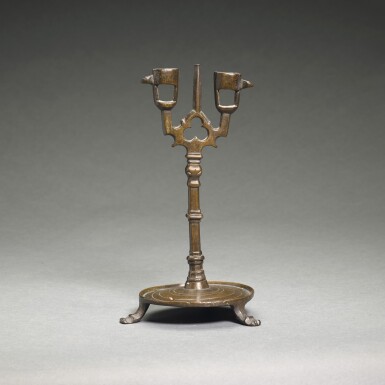
Property Restituted to the Heirs of E. Vita Israel
Probably Netherlandish, early 15th century | Candelabrum
Lot Closed
December 5, 03:04 PM GMT
Estimate
5,000 - 7,000 GBP
Lot Details
Description
Property Restituted to the Heirs of E. Vita Israel
Probably Netherlandish, early 15th century
Candelabrum
bronze
inscribed: 28 to the underside
22cm., 8 5/8 in.
his posthumous sale, Frederik Müller & Co, Amsterdam, 5-7 November 1940, lot 198;
J. W. Frederiks, the Netherlands;
by descent to his daughter, E. Frederiks, 1962;
on loan to the Boijmans Van Boiningen Museum, Rotterdam, from 1968, and donated to the museum by the above in 1994, inv. no. KA 116;
restituted to the heirs of Emanuel Vita Israel in 2020
The present lot is similar in form to several Netherlandish candelabra from the early 15th century in the Rijksmuseum, Amsterdam. Compare in particular op. cit. no. 139 for the base with feet, and op. cit. no. 144 for another example with a double socket and tracery ornament.
Along with the Romanesque situla (lot 1), the candelabrum formed part of the collection of Emanuel Vita Israel (1873-1940), one of the foremost Jewish art collectors in Amsterdam. A pharmacist, Vita Israel was a prominent member of the Portuguese-Jewish Congregation. His art collection, which ranged from Old Master paintings to medieval and Renaissance metalwork, was housed in rooms above his pharmacy, and he was known to showcase it to curious visitors. Vita Israel’s passion for art translated into philanthropy; he was one of the founders and key supporters of the Jewish Historical Museum in Amsterdam, which opened in 1932. On 15 May 1940, shortly after the German invasion of the Netherlands, Emanuel Vita Israel took his own life. Prior to his suicide, he had amended his will to stipulate the sale of his art collection within six months after his death. Vita Israel's entire family, apart from his daughter-in-law and two granddaughters, were deported and died in a concentration camp.
The situla and candelabrum were purchased at the auction of Vita Israel’s estate by the Dutch collector J.W. Frederiks (1889-1962), whose descendants donated it to the Museum Boijmans van Beuningen. In 2020 the Restitutions Committee of the Netherlands found that Vita Israel’s suicide and the sale of his collection were a direct result of circumstances related to the Nazi regime. The two pieces were consequently restituted by Rotterdam City Council to the heirs of Emanuel Vita Israel.
RELATED LITERATURE
O. ter Kuile, Koper & Brons, cat. Rijksmuseum, Amsterdam, 1986, 132-144
